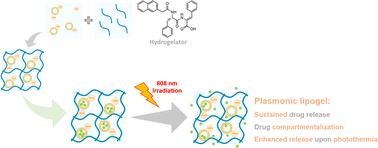Plasmonic lipogels: driving co-assembly of composites with peptide-based gels for controlled drug release†
Abstract
Supramolecular short peptide-based gels are promising materials for the controlled release of drugs (e.g. chemotherapeutic drugs) owing to the biocompatibility and similarity to cell matrix. However, the drug encapsulation and control over its release, mainly the hydrophilic drugs, can be a cumbersome task. This can be overcome through encapsulation/compartmentalization of drugs in liposomes, which can also enable spatiotemporal control and enhanced drug release through a trigger, such as photothermia. Having this in mind, we explored the assembly of silica-coated gold nanoparticles and liposomes (storage units) with dehydropeptide-based hydrogels as a proof-of-concept to afford peptide-based NIR light-responsive lipogels. Several liposomes compositions were assessed that displayed influence on the final assembly properties by combining with silica-coated gold nanorods (∼106 nm). Gold nanospheres (∼11 nm) were used to study the preparation method, which revealed the importance of initially combine liposomes with nanoparticles and then the gelator solution to achieve a closer proximity of the nanoparticles to the liposomes. The control over a hydrophilic model drug, 5(6)-carboxyfluorescein, was only achieved by its encapsulation in liposomes, in which the presence of silica-coated nanorods further enabled the use of photothermia to induce the liposomes phase transition and stimulate the drug release. Further, both composites, the liposomes and silica-coated gold nanorods, induced a lower elastic modulus, but also provided an enhanced gelation kinetics. Hereby, this work advances fabrication strategies for the development of short peptide-based hydrogels towards on-demand, sustained and controlled release of hydrophilic drugs through photothermia under NIR light irradiation.



 Please wait while we load your content...
Please wait while we load your content...